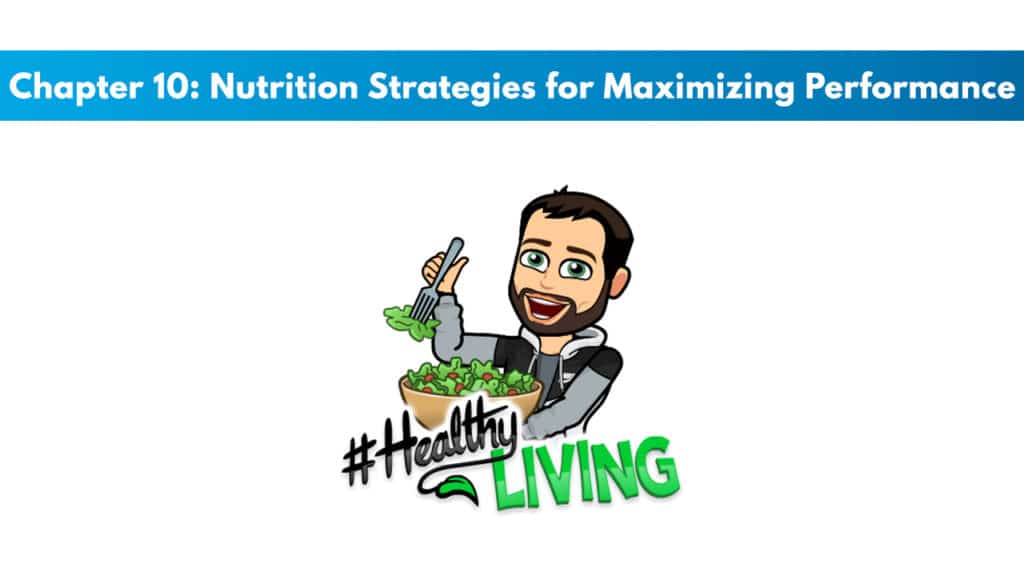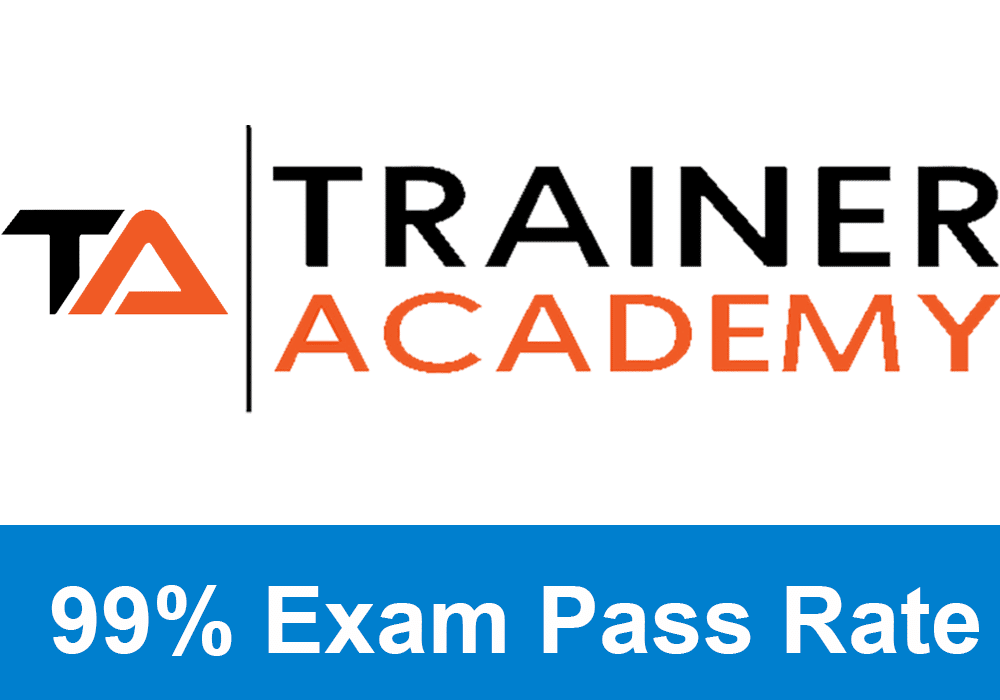
Get your copy of the NSCA CSCS exam cheat sheet. It helps immensely in studying for the exam.
My PTP students report cutting their CSCS study time and effort in half with Trainer Academy.
Benefit from the Exam Pass Guarantee and Retake Fee Guarantee. Plus, take advantage of my current discount code PTPJULY for 35% off the MVP Program (Ends July 15th, 2025).
Try it out for free here to see if it’s right for you, or read my detailed review for further insights.
Chapter Goals
- Know the pre, during, and post-competition sports recommendations for nutrition.
- Have Guidelines for gaining and losing weight.
- Be able to see the signs and symptoms of eating disorders.
- Know the reasons to have intervention and referral systems for athletes that are suspected to have an eating disorder.
- Be able to see the etiologies and prevalence of obesity.
- Help the process of assessing obese individuals.
Pre-competition, During event, and Post Competition Nutrition
Pre-Competition Nutrition
Planning meals should look at timing, meal and fluid composition, events and sports, and the preferences of individuals.
To lessen the possibility of upset stomach, we should consume smaller amounts of fluids and food if the meal is closer to the competition.
Precomp food and beverages should be something the athlete is familiar with and limit gastrointestinal stress.
Sugar alcohols that are found in low carb and sugar free drinks should be avoided. They can cause distress in your stomach.
Athletes should choose between low and high glycemic carbs before competitions. Research shows that it doesn’t matter too much what you take in.
Aerobic endurance sports
Precomp meals are more important for athletes who train in aerobic endurance activities that are longer than 2 hours in the morning.
Carbs in precomp meals can help with glycogen stores and improve people’s exercise exhaustion time. These are typically the most beneficial 3 or more hours before competition.
High carb meals with a sports drink during the run portion improved endurance capacity by 22% when compared to a placebo before competition and a sports drink during the run.
Endurance athletes that are not adapted to low carb diets and start exercising with lessened stores of glycogen will begin to break down muscle to use proteins for energy.
Chronic consumption of low carb diets will increase its reliance on fat stores.
General guidelines
Prehydrate hours before an event or exercise to allow fluids to absorb and output urine.
If athletes get a precomp meal in, they need 1 gram of carbs per kilo of body weight.
Prolonged activity in hot weather should accompany a sports drink with 20 – 30 mEq of sodium, 2 – 5 mEq of potassium, and should be 5 – 10% carbs.
Liquid carbs are preferred if you are within an hour of an event.
Carbohydrate Loading
This benefits distance runners, cyclists, skiers, and other aerobic endurance athletes.
The most common carb loading regimen
Three days of high carb dieting along with tapered exercise a week before competition and an entire day of rest the day before competing.
8 – 10 grams of carbs per kg. this will increase the store of muscle glycogen by 20 – 40%.
10 – 12 grams of carbs per kg is suggested for people 2 days before a marathon.
Some studies show that carb loading is more effective in men.
Women consuming 2,400 or less calories may find consuming more carbs difficult.
So, females may need first to increase intake to over 2,400 Cals.
During Event Nutrition
This is used for aerobic endurance activities for over 45 minutes.
Athletes need to take in enough fluids during exercise to prevent loss of water weight over 2%.
Exclusive PTP CPT Offers |
||
|---|---|---|
Most Popular Cert | Best Online NCCA Cert | Best Study Materials |
Gold Standard Cert | A Good Option | Best CPT for you?  |
Again, optimal sports drinks have 20 – 30 mEq of sodium and 2 – 5 mEq of potassium and consist of 5 – 10% of carbs.
Children
88 pound children need 5 ounces of fluids every 20 minutes.
132 pound children need 9 ounces every 20 minutes.
Sodium chloride concentrations equaling 15 – 20 mmol/L increases hydration by 90% compared to water.
Aerobic Endurance Sports
Sports drinks are unable to keep up with aerobic endurance sports.
People doing these should consume 30 – 90 grams of different types of carbs together each hour during prolonged activity.
Rinsing carbs in your mouth improves one hour performance by 2 – 3%.
Protein addition leads to greater times until exhaustion during cycling bouts.
Intermittent High Intensity Sports
Soccer, tennis, basketball, and football all involve repeating short and high intensity bouts of activity.
Strength and Power Sports
Participants use a lot of their muscle glycogen.
Maintaining glycogen stores will decrease fatigue and lead to better performances.
Post Competition Nutrition
Aerobic Endurance Events
Intense endurance activities, like a marathon, will lead to a delay in resynthesis of glycogen even when athletes consume higher carb diets.
It isn’t always necessary to eat immediately after a competition. It is ok to wait 2 hours.
Athletes with 24 hours or more for recovery can wait to eat after exercise and gradually replace carbs.
If an athlete has less than 24 hours, they should immediately consume food or drink after finishing the event.
Aerobic endurance breaks down muscle tissue; thus, we should include protein in the post training meals.
Protein also increases the rate of glycogen stores if carb intake is inadequate.
High intensity Intermittent Sports
Replacing muscle glycogen fully before subsequent bouts of exercise or competition will prolong time to fatiguing and improve athletic performance.
Consuming protein following exercise will help to decrease some markers from muscle damage.
Strength and Power Sports
It is important to restore levels of glycogen prior to the next bout of exercise.
High glycemic carbs should be a focus over the 24 hours following training or competition.
Carbs don’t have an effect on the synthesis of proteins, but they do prevent the breakdown of proteins that happens in resistance exercise.
Small amounts of carbs between 30 and 100 grams reduces muscle protein breakdowns.
Taking in protein after damaging muscle will increase the synthesis of muscle proteins.
Different amounts of proteins have been used after resistance training. For young people, 20 – 25 grams are recommended, and 40 grams or more is recommended for adults.
Protein doses containing 2 – 3 grams of leucine can stimulate muscle protein stimulus to the maximum levels in younger adults.
Concurrent Training
This is training that includes both endurance and strength training.
Exclusive PTP CPT Offers |
||
|---|---|---|
Most Popular Cert | Best Online NCCA Cert | Best Study Materials |
Gold Standard Cert | A Good Option | Best CPT for you?  |
Carb consumption following endurance and prelift exercise may be able to suppress the breakdown of skeletal muscles.
Athletes need to consider protein consumption following or during these types of exercise.
Protein at Mealtime
Optimal muscle remodeling research suggest 20 – 30 grams of protein per meal and meals eaten every 3 – 4 hours.
Nutrition Strategies to Alter Body Composition
First, calorie needs need to be estimated.
The number of calories athletes need daily depends on factors like body weight, genetics, body composition, age, and training programs.
BMR, or Basal Metabolic Rate, is the greatest contributor to total energy expenditure. It accounts for between 65 and 70% of daily energy expenditure.
Caloric measures required for regular bodily functions include breathing, circulation, and GI and renal processing.
BMR and RMR are often used as the same but slightly different.
To measure BMR, you must go 12 – 14 hours without food and rest supine and motionless, but they must be awake.
The second biggest component of total energy requirement is physical activity.
20 – 30% of total daily energy expenditure occurs from physical activity, but for athletes, it may be higher.
Thermic effects of food increase energy expenditure over the RMR can be measured for hours following a meal.
This is about 10 – 15% of total burned calories each day
There are equations to calculate caloric needs
Harris-Benedict takes sex, weight, height, and age and uses them to predict RMR. They use RMR times activity factors of 1.2 for sedentary and 1.9 for heavy physical activity to predict the requirements for energy.
Cunningham equation uses the same variables but also has fat free mass; thus, it is more relevant for athletes.
RMR = 550 + 22(LBM)
Activity factors can again be used for this equation.
Weight Gain
Increasing caloric intake quickly may lead to a lot of fat gain.
Generally, athletes should consume 500 more calories per day to gain weight.
Athletes need to ensure they eat enough protein or their lean body mass gains. This is 1.5 – 2.0 grams per kg.
Creatine monohydrate is a supplement used to increase lean body weight safely.
Regular nutrition counseling is very beneficial.
Weight /Fat Loss
Consuming fewer calories is what is most important, no matter the diet.
Dietary adherence is another critical component, along with total calorie intake.
Muscle loss may be a bigger portion of weight loss.
More protein should be consumed in the realm of 1.8 – 2.7 grams per kg even while reducing calorie intake.
Overweight and Obesity
Weight loss goals for overweight and obese people initially needs to be 10% of their starting weight in the first six months.
Body mass index, BMI, is calculated using both height and weight.
BMI can be used for risk assessment.
BMI is not a diagnostic tool but a screening tool used for finding possible weight issues in people and tracking overall population rates.
To calculate BMI, you use Body weight in kilograms divided by height in meters.
The classifications are:
- Underweight is < 18.5
- Normal is 18.5 – 24.9
- Overweight is 25.0 – 29.9
- Obesity 1 is 35.0 – 39.9
- Obesity 2 is 35.0 – 39.9
- Extreme Obesity is > 40
We also use waist circumference to assess risk of disease.
- For men, 40 inches or more is increased risk,
- For women, 35 inches or more is for increased risk.
Rapid Weight Loss
There are weight loss techniques that are very dangerous. These include fasting, fad diets, voluntary dehydration, laxative abuse, self-inducing vomiting, excessive spitting, and inappropriate and excessive use of thermogenic aids.
Feeding and Eating Disorders
Anorexia Nervosa:
Distorted body image and a fear of gaining any weight. This leads to excessive restriction of calories and severe weight loss.
Two Subtypes
Restrictors do not binge eat or purge typically.
Binge eaters and purgers regularly purge or binge eat.
Symptoms
- Bone thinning
- Hair and nails become frail
- Dry, yellow skin
- Severe constipation
- Anemia
- Brain damage
- Low BP
- Multiorgan failure
- Lethargy
- Infertility
Binge Eating Disorder:
Involves repeated episodes of uncontrolled eating.
Typically associated behaviors
Eating more rapidly
Eating until uncomfortable
Eating a ton when you aren’t hungry
Eating alone due to embarrassment
Feeling disgusted with yourself after eating
Binging is not followed with purging.
Bulimia Nervosa:
Eating great amounts of food and then purging after.
People are likely a normal weight instead of under. They are unhappy with their body.
Symptoms:
- Sore throat
- Worn tooth enamel
- Severely dehydrated
- Swollen salivary glands
- Acid reflux disorder
- Electrolyte imbalances
Avoidant/Restrictive Food Intake Disorder:
Lack of interest in eating food. Avoiding basic sensory characteristics of food.
May include one or more of these
- Rapid weight loss
- Significant deficiency of nutrients
- Dependence on enteral feeding
- Psychosocial function interference
Pica:
People will eat nonnutritive substances for one month or more.
Things like clay, laundry starch, ice, cigarettes, hair, or chalk are eaten.
Rumination Disorder:
Chewing, reswallowing, spitting of regurgitated food.
Eating Disorder Management and Care
Strength and conditioning staff should be aware of the symptoms, but they should not be the ones to treat them as its not in their scope of practice.
Check out Trainer Academy for the best CSCS study materials. They even offer an exam pass guarantee. They have incredible study materials for the CSCS and I have a special limited-time discount for my readers. I also suggest you check out my review on Trainer Academy here.

 Have a question?
Have a question? 



Tyler Read
PTPioneer Editorial Integrity
All content published on PTPioneer is checked and reviewed extensively by our staff of experienced personal trainers, nutrition coaches, and other Fitness Experts. This is to make sure that the content you are reading is fact-checked for accuracy, contains up-to-date information, and is relevant. We only add trustworthy citations that you can find at the bottom of each article. You can read more about our editorial integrity here.